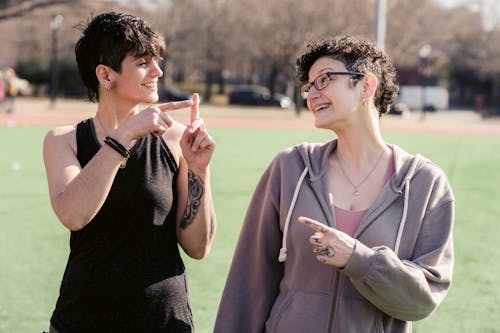🌎ASL Level 3, Activity 13-Universal Classifiers (Face-to-Face)
Description:
Students will learn about classifiers and how they are universally useful. They will also practice fingerspelling and take part in a game that will allow them to get to know each other better.
Products: Understanding the significance of classifiers and expressing personal information, communication skills
Practices: Possibly utilizing universal aspects of sign language and playing two truths and a lie using facts about yourself
Perspectives: Although sign language is not universal, a person who knows American Sign Language and someone who knows French Sign Language can still communicate on a very basic level. Also, talking about personal information and being open is common in the Deaf community.
Standards
AATSP Standards for Learning American Sign Language:
- “Standard 1.1 – Students engage in conversations and correspondence in American Sign Language to provide and obtain information, express feelings and emotions, and exchange opinions”
- “Standard 1.3 – Students present information, concepts, and ideas in American Sign Language to an audience of viewers on a variety of topics”
- “Standard 4.1 – Students demonstrate an understanding of the nature of language through comparisons of American Sign Language and their own languages.”
Idaho Content Standards for World Languages:
- “COMM 1: Interact with others in the target language and gain meaning from interactions in the target language”
- “COMM 1.1: Interact and negotiate meaning (spoken, signed, written conversation) to share information, reactions, feelings, and opinions”
- “COMP 2: Investigate, explain, and reflect on the concept of culture through comparisons of the cultures studied and their own”
Can-Do Statements
NCSSFL-ACTFL Can-Do Statements:
- I can discuss topics that are interesting to me
- I can describe facts about myself
- I can understand messages portrayed exclusively visually
Materials Needed
Warm-up
Materials Needed for Warm-up
- Start with 5-minute conversations
- “START TIME 5 MINUTE CONVERSATION DISCUSS THANKSGIVING WHATEVER WANT”
- Visual Vernacular!
- Watch the two videos signed by Deaf people from different parts of the world
- “NOW 2 VIDEOS WATCH CL DIFFERENT AREA WORLD”
- When the videos are over have a group discussion.
- What was understood?
- “UNDERSTAND?”
- How did classifiers support your understanding?
- “CLASSIFIERS HELP UNDERSTANDING HOW?”
- What do you know about sign language in other countries?
- “YOU DIFFERENT COUNTRY SIGN LANGUAGE KNOW WHAT?”
- Reflect on the similarities and differences of the Mexican Sign Language Alphabet
- “MSL SAME DIFFERENT WHAT?”
MAIN ACTIVITY
Materials Needed for Main Activity
- Fingerspelling & Game
- Have students get into pairs
- Each student will pick 5 words to fingerspell to their partners and then switch
- Be sure to emphasize that we need to fingerspell clearly
- “PARTNERS TAKE TURNS FINGERSPELL YOU PICK 5 WORDS”
- Two Truths and a Lie
- Each student will come up with two true facts about themselves and one lie
- Each student will go around and share their facts
- The rest of the group will guess which is the lie
- Once everyone has guessed, explain which is a lie and then have that student share some more details on the true facts
- “TAKE TURNS SIGN 2 TRUTHS 1 LIE. FINISH GROUP GUESS LIE WHICH. EXPLAIN TRUE”
- “GROUP QUESTIONS ASK FINISH NEW PERSON SIGN 2 TRUTHS ONE LIE CONTINUE ALL”
***The goal of this game is to foster conversation in the target language**
Wrap Up
- What have you learned about Deaf culture around the world?
- “YOU DEAF CULTURE ALL WORLD LEARN WHAT?”
- What is the importance of CLs?
- “CLS IMPORTANT WHY?”
- Do you feel comfortable signing information about yourself?
- “YOU SELF INFORMATION SHARE COMFORTABLE FEEL?”
Cultural Notes
Different sign languages have different signs and customs. This makes it difficult for people to communicate with others in foreign countries via sign language. However, classifiers are universal. A story told exclusively using classifiers can be understood by Deaf individuals/signers around the world.
End of Lab:
- Sign or show Can-Do statements once more and have students evaluate their confidence
- (Use thumbs up/ thumbs down or have them rate 1-5 on how they feel after the activity)
- Encourage students to be honest in their self-evaluation
- Pay attention, and try to use feedback for future labs!
Can-Do Statements
NCSSFL-ACTFL Can-Do Statements:
- I can topics that are interesting to me
- I can describe facts about myself
- I can understand messages portrayed exclusively visually


